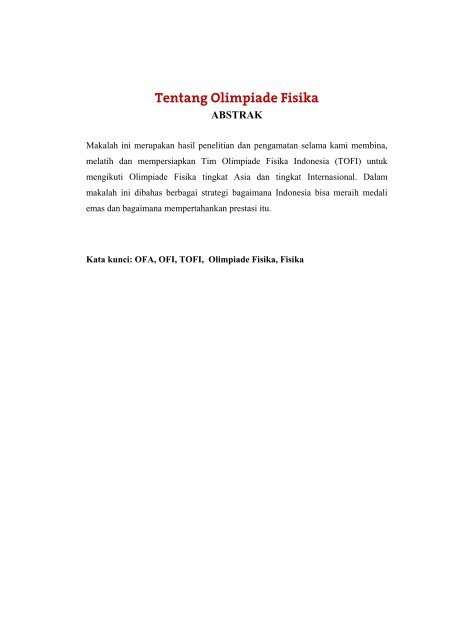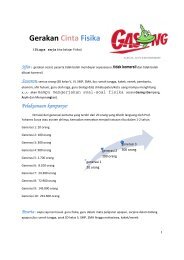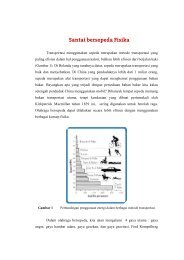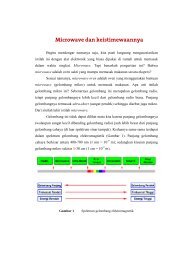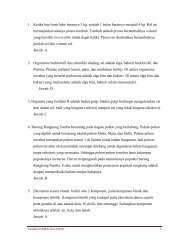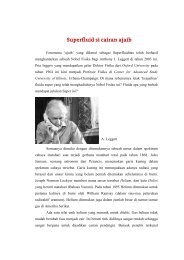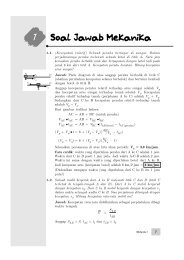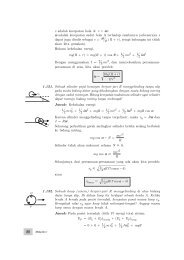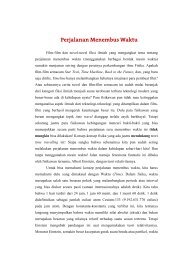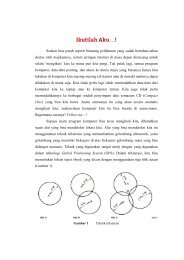Tentang Olimpiade Fisika (Pdf) - Yohanes Surya.com
Tentang Olimpiade Fisika (Pdf) - Yohanes Surya.com
Tentang Olimpiade Fisika (Pdf) - Yohanes Surya.com
- No tags were found...
Create successful ePaper yourself
Turn your PDF publications into a flip-book with our unique Google optimized e-Paper software.
<strong>Tentang</strong> <strong>Olimpiade</strong> <strong>Fisika</strong>ABSTRAKMakalah ini merupakan hasil penelitian dan pengamatan selama kami membina,melatih dan mempersiapkan Tim <strong>Olimpiade</strong> <strong>Fisika</strong> Indonesia (TOFI) untukmengikuti <strong>Olimpiade</strong> <strong>Fisika</strong> tingkat Asia dan tingkat Internasional. Dalammakalah ini dibahas berbagai strategi bagaimana Indonesia bisa meraih medaliemas dan bagaimana mempertahankan prestasi itu.Kata kunci: OFA, OFI, TOFI, <strong>Olimpiade</strong> <strong>Fisika</strong>, <strong>Fisika</strong>
PENDAHULUAN<strong>Olimpiade</strong> <strong>Fisika</strong> Internasional (OFI) merupakan kompetisi internasional dalambidang fisika untuk pelajar SMU. Beberapa tujuan penyelenggaraan OFI antaralain: untuk membandingkan kemampuan para siswa terbaik dari berbagai negaradalam bidang fisika; untuk mengadakan kerjasama dan saling berbagi pengalamanmengembangkan fisika diantara sesama pimpinan tim dan untuk memberikesempatan para pelajar terbaik dari seluruh dunia berinteraksi satu sama lainserta membangun kerjasama yang mungkin berguna di kemudian hari.OFI pertama kali diadakan di Warsawa pada tahun 1967 dan sejak tahun itu OFIdiadakan secara rutin setiap tahun di berbagai negara, kecuali tahun 1973, 1978dan 1980. Dalam OFI para peserta diberikan 2 jenis soal: soal fisika teori dansoal fisika eksperimen yang harus dikerjakan masing-masing dalam waktu 5 jam (1)Indonesia berpartisipasi di <strong>Olimpiade</strong> <strong>Fisika</strong> Internasional sejak tahun 1993 atasprakarsa 2 orang mahasiswa College of William and Mary: <strong>Yohanes</strong> <strong>Surya</strong> danAgus Ananda. Sejak tahun itu Indonesia secara rutin mengikuti <strong>Olimpiade</strong> <strong>Fisika</strong>Internasional bahkan Indonesia diminta untuk menjadi tuan rumah <strong>Olimpiade</strong><strong>Fisika</strong> Asia (OFA) pertama pada tahun 2000 (2)Dalam makalah ini kami akan menyoroti strategi-strategi yang harus kita lakukanagar setiap tahun kita dapat menjadi juara di <strong>Olimpiade</strong> <strong>Fisika</strong> Asia maupun di<strong>Olimpiade</strong> <strong>Fisika</strong> Internasional, dengan meraih sebanyak mungkin medali emas.Untuk itu makalah dibagi dalam 5 bagian. Bab pertama makalah ini akanmembahas sejarah OFI dan OFA serta perkembangannya. Sedangkan pada Bab 2kita akan melihat partisipasi dan hasil yang dicapai oleh putra-putri Indonesiadalam olimpiade yang sangat bergengsi ini. Dalam Bab 3 kita akan membahassoal-soal dan sistem penilaian dalam olimpiade fisika. Selanjutnya dalam Bab 4kita akan melihat alasan mengapa prestasi yang baik dalam olimpiade fisika harusdipertahankan. Dan akhirnya dalam Bab 5 kita akan membahas strategi-strategimacam apa yang harus dilakukan agar Indonesia mampu mempertahankanprestasi yang telah dicapainya ini bahkan memperbaikinya hingga menjadi juaradalam kedua olimpiade fisika. Makalah akan ditutup dengan kesimpulan.1
1. SEJARAH OLIMPIADE FISIKAIde penyelenggaraan OFI berawal dari keberhasilan dan dampak positif daripenyelenggaraan <strong>Olimpiade</strong> Matematika Internasional (OMI) yang telahdiselenggarakan sejak tahun 1959. Saat itu Prof. Czelaw Scislowski, Prof.Rostislav Kostial (Cekoslowakia), dan Prof. Rudolf Kunfalvi (Hongaria)mengadakan rapat untuk mengadakan OFI pertama, dan mereka sepakat untukmengadakan olimpiade ini di Warsawa pada tahun 1967.OFI pertama ini diikuti oleh 5 negara: Bulgaria, Cekoslowakia, Hungaria,Rumania dan tuan rumah Polandia. Tiap negara mengirimkan 3 wakilnya dan 1pimpinan tim. Pada olimpiade fisika ini para peserta diminta untuk mengerjakan 4soal fisika teori dan 1 soal fisika eksperimen.OFI ke -2 diadakan di Budapest (Hongaria) pada tahun 1968, diikuti oleh 8 negarayaitu 5 negara dari OFI ke -1 ditambah 3 negara yaitu Republik DemokrasiJerman (Jerman Timur), Uni Sovyet dan Yugoslavia. Pada OFI ke -2 ini untukpertamakali aturan dasar OFI di terbitkan yang sampai sekarang ini masih dipakai(tentunya dengan perubahan-perubahan sedikit).OFI ke -3 diadakan di Brno, Cekoslowakia pada tahun 1969. Pada OFI ini tiapnegara boleh mengirim 5 siswa dan 2 orang pimpinan tim. Sampai sekarangjumlah 5 siswa dan 2 pimpinan tim untuk tiap negara ini tetap dipertahankan. OFIIV diadakan di Moskow, Uni Sovyet pada tahun 1970, OFI V di Sofia, Rumaniapada tahun 1971 dan OFI VI di Bukares, Rumania pada tahun 1972. Pada OFI VIinilah untuk pertamakalinya negara non-eropa: Kuba dan negara Eropa Barat:Perancis, ikut serta.Tahun 1973 tidak diadakan olimpiade fisika. OFI VII diadakan baru pada tahun1974. Dalam OFI VII ini terjadi perubahan-perubahan mendasar yaitu jumlah soalteori dikurangi dari 4 soal menjadi 3 soal; jumlah bahasa yang digunakan menjadi2 bahasa yaitu bahasa Inggris dan bahasa Rusia; antara soal test teori daneksperimen diberi selang waktu 1 hari.2
Daftar lengkap penyelenggara OFI diberikan pada tabel 1. Hal penting yang patutdicatat adalah pada OFI ke XV terpilih Prof. Waldemar Gorzkowski sebagaiPresiden OFI yang dijabatnya hingga sekarang. Pada olimpiade ini juga dibentukInternational Board yang terdiri dari para pimpinan tim tiap negara. TugasInternational Board ini adalah untuk memecahkan masalah-masalah yang timbulpada penyelenggaraan OFI.Jika diamati minat untuk mengikut OFI setiap tahun meningkat. Jumlah negarayang berpartisipasi terus meningkat dari 5 negara di OFI pertama terus bertambahhingga menjadi 66 negara dalam OFI ke 33 yang diadakan di Bali tahun 2002yang baru lalu. Ke 66 negara yang berpartisipasi dalam OFI ke 33 adalah:Albania, Armenia, Australia, Austria, Azerbaijan, Belarus, Belgium, Bolivia,Bosnia & Herzegovina, Brazil, Bulgaria, Canada, China, Colombia, Croatia,Cuba, Cyprus, The Czechlands, Denmark, Estonia, Finland, Georgia, Germany,Great Britain, Hungary, Iceland, India, Indonesia, Iran, Ireland, Italy,Kazakhstan, Kuwait, Kyrgyzstan, Latvia, Liechtenstein, Lithuania, Macedonia,Malaysia, Mexico, Moldova, Mongolia, The Netherlands, Norway, Pakistan,Philippines, Poland, Portugal, Romania, Russia, Saudi Arabia, Singapore,Slovakia, Slovenia, South Korea, Spain, Suriname, Sweden, Switzerland, Taiwan,Thailand, Turkey, Turkmenistan, Ukraine, Vietnam, Yugoslavia.Peningkatan jumlah peserta ini ditunjukkan pada Gb 1.3
PESERTA OFI806040200135Jumlah Negara791113151719212325272931<strong>Olimpiade</strong>Gb. 1. Peningkatan jumlah negara yang berpartisipasi dalam <strong>Olimpiade</strong> <strong>Fisika</strong>Internasional.Tabel 1 Tuan rumah <strong>Olimpiade</strong> <strong>Fisika</strong> Internasional sampai tahun 2020 (3)Yang Lalu:Yang Akan datang:No. Tahun Tempat Negara No. Tahun NegaraII 1967 Warsaw Poland XXXIV 2003 TaiwanIII 1968 Budapest Hungary XXXV 2004 SouthKoreaIV 1969 Brno Czechoslovaki XXXVI 2005 SpainaV 1970 Moscow Soviet Union XXXVII 2006 SingaporeVI 1971 Sofia Bulgaria XXXVIII 2007 IranVII 1972 Bucharest Romania XXXIX 2008 VietnamVIII 1974 Warsaw Poland XL 2009 MexicoIX 1975 Guestrow GDR XLI 2010 CroatiaX 1976 Budapest Hungary XLII 2011 Belgium4
XI 1977 HradecCzechoslovaki XLIII 2012 EstoniaKralove aXII 1979 Moscow Soviet Union XLIV 2013 DenmarkXIII 1981 Varna Bulgaria XLV 2014 SloveniaXIV 1982 Malente FRG XLVI 2015 IrelandXV 1983 Bucharest Romania XLVII 2016 SwitzerlandXVI 1984 Sigtuna Sweden XLVIII 2017 MoldovaXVII 1985 Portoroz SFRXLIX 2018 PortugalYugoslaviaXVIII 1986 London- Great Britain L 2019HarrowXIX 1987 Jena GDR LI 2020 LithuaniaXX 1988 Bad Ischl AustriaXXI 1989 Warsaw PolandXXII 1990 Groningen TheNetherlandsXXIII 1991 Havana CubaXXIV 1992 Helsinki- FinlandEspooXXV 1993 Williamsburg USAXXVI 1994 Beijing ChinaXXVII 1995 Canberra AustraliaXXVIII 1996 Oslo NorwayXXIX 1997 Sudbury CanadaXXX 1998 Reykjavik IcelandXXXI 1999 Padova ItalyXXXII 2000 Leicester Great BritainXXXII 2001 Antalya TurkeyXXXIII 2002 Nusa Dua IndonesiaPada OFI, tuan rumah harus menyediakan soal fisika (baik soal teori maupun soaleksperimen) dalam 4 bahasa: Inggris, Rusia, Jerman dan Perancis. Kemudian parapimpinan tim tiap negara menterjemahkan soal-soal ini ke dalam bahasanyamasing-masing sehingga para peserta dapat mengerti soal yang ditanyakandengan baik.Para pemenang olimpiade fisika ini akan mendapat medali emas, perak, perunggudan honorable mention. Kriteria perolehan medali ini berkembang dari waktu kewaktu. Sampai tahun 2001, penentuan medali emas ditentukan sebagai berikut:mula-mula 3 nilai teratas di rata-rata kan, 90 % dari nilai rata-rata ini (dibulatkanke bawah) berhak mendapatkan medali emas, 78 % perak (dibulatkan kebawah),65 % perunggu (dibulatkan ke bawah) dan 50 % honorable mention (dibulatkanke bawah) (1) . Tapi sejak tahun 2002 dicoba aturan baru yang dianggap lebih baik5
(dengan aturan baru ini pihak penyelenggara dapat memperkirakan lebih baik,berapa medali yang harus ia siapkan). Dalam aturan baru ini (3) mula-mula tuanrumah memberikan nilai untuk tiap peserta, berdasarkan nilai ini kemudianditentukan: (lihat Apendik 1)a) jumlah minimum medali emas yang diberikan adalah 6 % dari seluruhpeserta yang hadir.b) Jumlah minimum peraih perak atau emas adalah 18 % dari seluruhpeserta.c) Jumlah minimum peraih perunggu, perak atau emas adalah 36% dariseluruh peserta.d) Jumlah minimum yang meraih honorable mention, perunggu, perak atauemas adalah 60% dari seluruh peserta.e) Jumlah minimum (6%, 18%, 36% dan 60 %) harus dinyatakan dalambilangan bulat dengan pembulatan ke bawah.f) Jumlah minimum ini harus disetujui melalui pemungutan suara dimanaseparuh atau lebih anggota International Board (yang terdiri dari parapimpinan tim) menyetujuinya.Peserta yang mendapatkan nilai tertinggi menerima hadiah khusus.OLIMPIADE FISIKA ASIA<strong>Olimpiade</strong> <strong>Fisika</strong> Asia (OFA) merupakan kompetisi fisika tingkat Asia.<strong>Olimpiade</strong> ini diadakan dengan tujuan agar tim-tim Asia lebih siap dalammengahadapi OFI. Disamping itu diharapkan agar pelajar-pelajar di Asia dapatsaling mengenal satu sama lain untuk kerjasama lebih jauh dimasa mendatang.Juga diharapkan para pimpinan tim dapat mendiskusikan kurikulum sertamenghasilkan suatu kurikulum yang bagus untuk siswa-siswa di Asia.<strong>Olimpiade</strong> <strong>Fisika</strong> Asia diadakan pertamakali di Karawaci, Tangerang, Indonesiapada bulan April 2002 atas inisiatif Prof. Waldemar Gorzkowski dan <strong>Yohanes</strong>6
<strong>Surya</strong>. OFA pertama ini di ikuti oleh 10 negara. Aturan-aturan dan silabus dalamOFA mengacu pada aturan-aturan OFI (4) . Aturan pemberian medali masihmengikuti aturan lama dari OFI yaitu berdasarkan nilai rata-rata dari 3 nilaitertinggi. Pada OFA pertama ini terpilih <strong>Yohanes</strong> <strong>Surya</strong> sebagai Presiden OFAdan Ming Juey Lin dari Taiwan sebagai sekretaris.OFA ke 2 diadakan di Taipei, Taiwan tahun 2001 diikuti oleh 12 negara. PadaOFA ini karena alasan politik, China tidak berpartisipasi. OFA III diadakan diSingapore dengan 16 negara peserta. Sedangkan OFA IV diadakan di Thailandtahun 2003 hanya diikuti oleh 10 negara (semula 19 negara menyatakan diri akanberpartisipasi, namun karena ada penyakit SARS maka 9 negara mengundurkandiri). Tabel 2 menunjukkan negara-negara yang berpartisipasi dalam OFA Isampai IV. Sedangkan pada tabel 3 ditunjukkan negara-negara yang akan menjadituan rumah OFA.7
Tabel 2: Negara Penyelenggara OFANegara Penyelenggara OFA<strong>Olimpiade</strong>Tahun1 2 3 4 5 6 7 8 9 0200...0 1 2 3 4 5 6 7 8 9Negara0 Australia G # # #1 Brunei O - - -2 China # - # -3 Georgia - - # -4 India O # - -5 Indonesia H # # #6 Israel - # # #7 Japan - O - -8 Jordan - # - -9 Kazakhstan # # # -10 Kyrgyzstan - - # #11 Laos - - - #12 Malaysia O # # -13 Mongolia - # # -14 Pakistan - - - #15 Philippines # - - #16 Qatar - O - -17 Singapore # # H -18 South Korea - - O -19 Taiwan # H # #20 Thailand # # # #21 Turkey - - # -22 Uzbekistan # - # -23 Vietnam # # # #Keterangan:# : pesertaH : tuan rumah - penyelenggaraO : pengamatG : Tim tamu.8
Tabel 3: Tuan rumah <strong>Olimpiade</strong> <strong>Fisika</strong> Asia (3) .Yang lalu:Tuan Rumah <strong>Olimpiade</strong> <strong>Fisika</strong> AsiaNo Tahun Tempat Negara TanggalI 2000 Karawaci Indonesia 23 April - 2 MeiII 2001 Taipei Taiwan 22 April - 1 MeiIII 2002 Singapore Singapore 6 Mei - 14 MeiIV 2003 Bangkok Thailand 20 - 29 AprilMendatangTempat Tahun Tempat Negara StatusV 2004 Hanoi Vietnam 26 April - 4 MeiVI 2005 Riau Indonesia OkVII 2006 - Georgia belumVIII 2007 - China belumIX 2008 - Australia belumX 2009 - Uzbekistan belumXI 2010 - Malaysia belumXII 2011 - Israel Ok2 Partisipasi Indonesia dalam <strong>Olimpiade</strong> <strong>Fisika</strong>Indonesia mulai ikut <strong>Olimpiade</strong> <strong>Fisika</strong> Internasional (OFI) tahun 1993. Waktu initidak banyak orang tahu tentang olimpiade fisika. Pemerintahpun belum melirikpada olimpiade ini, juga orang-orang di Indonesia tidak mengenal akan OFI ini.Sehingga waktu diadakan test seleksi memilih siswa-siswa, hanya 56 siswa yangikut test seleksi awal. Dari 56 siswa ini dipilih 5 siswa. Siswa ini dilatih selama 2bulan. Hasilnya ternyata Indonesia mampu meraih 1 medali perunggu (atas namaOki Gunawan) dan 1 honorable mention (atas nama Jemmy Widjaja) dalam<strong>Olimpiade</strong> <strong>Fisika</strong> Internasional ke 24 di Amerika Serikat. Indonesia menempatiposisi ke 16 dari 41 negara. Hasil ini sangat menggembirakan dan mendorongkami untuk meneruskan partisipasi Indonesia dalam OFI ini.9
Tahun 1994, Indonesia ikut serta dalam OFI XXV di China. Pembinaan kali inihanya 1 bulan, dan hasilnya kita tidak mendapat apa-apa. Melihat keadaan ini,kami memutuskan untuk lebih konsentrasi dalam membina tim olimpiade fisikaIndonesia. Selama 5 bulan peserta ditraining jarak jauh dan 2 bulan ditrainingintensif. Hasilnya ternyata sangat menggembirakan. Untuk pertama kali Indonesiameraih medali perak (atas nama Teguh Budimulia). Dalam OFI ke-26 di Canberraitu peserta Indonesia meraih hadiah semua yaitu 1 perak, 1 perunggu dan 3honorable mention. Pola pembinaan 2 bulan intensif dan 5 bulan jarak jauh iniberlangsung sampai tahun 1998 dan hasilnya adalah antara perunggu dan perak.Tahun 1999 mulai dipikirkan pembinaan yang lebih baik. Kali ini pembinaandilakukan 7 bulan intensif dan fokus pada pembenahan eksperimen dimana kitaselalu mendapat nilai rendah. Ternyata hasilnya sangat menggembirakan.Indonesia untuk pertamakalinya meraih medali emas (atas nama Made AgusWirawan) disamping 1 perak, 2 perunggu dan 1 honorable mention di Padua Italiapada OFI ke –30. Disini mulai diperoleh pola pembinaan yang lebih baik.Tahun 2000, Indonesia menjadi tuan rumah <strong>Olimpiade</strong> <strong>Fisika</strong> Asia. Penyitaanwaktu yang besar dalam penyelenggaraan OFA mengakibatkan tidakterkonsentrasinya pembinaan.Akibatnya dalam OFA, Indonesia hanya merebut 1perak (atas nama Zainul Abidin), 1 perunggu dan 2 honorable mention dan dalamOFI kita hanya merebut 4 perunggu dan 1 honorable mention.Tahun 2001 tim Indonesia mulai dipersiapkan lebih serius dengan memperbaikisegala kekurangan-kekurangan yang ada dalam pembinaan. Hasilnya adalahIndonesia meraih 1 medali emas, 1 medali perak dan 2 perunggu dan 3 honorablemention dalam OFA ke -2 di Singapore dan 2 perak, 2 perunggu dan 1 honorablemention dalam OFI ke -32 di Turki. Dengan hasil-hasil ini pemerintah mulaibanyak memberikan perhatian pada OFI.Tahun 2002 Indonesia menjadi tuan rumah OFI. Pemerintah mempunyai targetuntuk sukses dalam pelaksanaan, sukses dalam presitasi dan sukses menjadi tuanrumah yang baik. Dengan pelatihan selama 1 tahun penuh, target pemerintah10
untuk sukses dalam prestasi berhasil diraih. Yaitu Indonesia meraih 3 medaliemas, 1 perak dan 1 perunggu dalam OFI ke -33 di Bali, Juli 2002. Dua bulansebelumnya di Singapore dalam OFA ke -3 Indonesia juga merebut 1 medali emasdan 5 perunggu.Melalui pelatihan intensif 1 tahun ternyata Indonesia mampu meraih emas. Inimendorong kami untuk meneruskan pola pembinaan dan pelatihan yang ada.Pada OFA ke -4 di Thailand bulan Juli 2003, Indonesia secara gemilang meraihjuara se Asia dengan merebut 6 medali emas dan 2 honorable mention. Hasil inisangat luar biasa karena bisa mengalahkan Taiwan, yang selama ini dikenalsebagai juara dunia bersama-sama dengan China.Dalam OFI selama 10 tahun ini kita telah meraih 4 medali emas, 5 perak, 13perunggu dan 20 honorable mention. Sedangkan dalam OFA kita telah merebut 8emas, 1 perak, 6 perunggu dan 6 honorable mention. Gb. 2 melukiskan prestasiIndonesia selama 10 tahun dalam OFI kami menggunakan 4 poin untuk emas, 3poin untuk perak, 2 poin untuk perunggu dan 1 poin untuk honorable mention.2015Nilai1050Tahun93959799O1Gb. 2 Hasil yang dicapai Indonesia dalam OFI11
3 SOAL-SOAL DAN PENILAIAN DALAMOLIMPIADE FISIKAPada awalnya soal-soal dalam kompetisi OFI tidaklah terlalu sulit. Tingkatkesulitan soal-soal ini setara dengan tingkat kesulitan soal-soal yang diajarkandi bangku SMU. Tetapi dengan berjalannya OFI, tingkat kesulitan soal inisemakin lama semakin sulit. Soal-soal ini biasanya diberikan untuk melihatkemampuan dan kreativitas siswa untuk memecahkan soal-soal ini.Soal-soal yang diberikan sesuai dengan silabus yang diberikan pada apendik 2.A. SOAL TEORIPada tiap olimpiade terdapat 3 soal. Tiap soal diusahakan mencakup seluruhaspek fisika. Sehingga untuk menyelesaikan soal dibutuhkan pengetahuanyang cukup komprehensif tentang konsep-konsep fisika seperti mekanika,elektromagnetik, fisika modern dan sebagainya.Sebagai perbandingan mari kita lihat soal-soal teori yang diberikan pada OFI1 (Warsawa 1967, soal pertama), OFI XI (Moskow 1979, soal pertama), OFIXXVIII (Canada, 1997), OFI XXX1 (Inggris, 2000) dan OFI 33 (Bali 2002,seluruh soal). Soal dikutip sesuai dengan bahasa aslinya (bahasa Inggris).12
Soal OFI 1:1. A ball of mass M = 0,2 kg rests on a vertical column, height h = 5 m. Abullet, mass m = 0,01 kg, traveling at v 0 = 500 m/s, passes horizontallythrough the center of the ball. The ball reaches the ground at a distance ofs = 20 m. Where does the bullet reach ground? What part of the kineticenergy of the bullet was transferred as heat to the bullet?Soal OFI XI1. A space ship of mass m = 12 ton is revolving on a circular orbit about themoon in height h = 100m. In order to reach the surface of the moon its jetengine is switched on at point X for a short time. The velocity of the hot gasesissueing from the nozzles u = 10.000 m/s relative to the space ship. The radiusof the moon R = 1700 km, the acceleration of free fall on its surface g = 1,7m/s 2 . The space ship can reach the moon by two different methods (seefigure): a) arriving on the moon in point A, opposite to point X; b) touchingthe moon surface tangentially at point B after having given a momentumdirected toward the center of the moon at point X. Calculate the quantity offuel necessay in each case.BAXAX13
SOAL OFI XXVIINuclear Masses and StabilityAll energies in this question are expressed in MeV - millions of electron volts.One MeV = 1.6 10 -13 J, but it is not necessary to know this to solve the problem.The mass M of an atomic nucleus with Z protons and N neutrons (i.e. the massnumberA = N + Z) is the sum of masses of the free constituent nucleons (protons andneutrons) minus the binding energy B/c 2 .The graph shown below plots the maximum value of B/A for a given value of A, vs.A. The greater the value of B/A, in general, the more stable is the nucleus.Binding Energy per Nucleon(a) Above a certain mass number A , nuclei have binding energies which arealways small enough to allow the emission of alpha-particles (A=4). Use a linearapproximation to this curve above A = 100 to estimate A . (3 marks)For this model, assume the following:14
• Both initial and final nuclei are represented on this curve.• The total binding energy of the alpha-particle is given by B 4 = 25.0 MeV(this cannot be read off the graph!).(b) The binding energy of an atomic nucleus with Z protons and N neutrons(A=N+Z) is given by a semi-empirical formula:The value of is given by:+ a p A -3/4 for odd-N/odd-Z nuclei0 for even-N/odd-Z or odd-N/even-Z nuclei- a p A -3/4 for even-N/even-Z nucleiThe values of the coefficients are:a v = 15.8 MeV; a s = 16.8 MeV; a c = 0.72 MeV; a a = 23.5 MeV; a p = 33.5 MeV.(i) Derive an expression for the proton number Z max of the nucleus with the largestbinding energy for a given mass number A . Ignore the -term for this part only. (2marks)(ii) What is the value of Z for the A = 200 nucleus with the largest B/A? Includethe effect of the -term. (2 marks)(iii) Consider the three nuclei with A = 128 listed in the table on the answer sheet.Determine which ones are energetically stable and which ones have sufficientenergy to decay by the processes listed below. Determine Z max as defined in part(i) and fill out the table on your answer sheet.In filling out the table, please:• Mark processes which are energetically allowed thus:• Mark processes which are NOT energetically allowed thus: 0• Consider only transitions between these three nuclei.Decay processes:15
(1) - - decay; emission from the nucleus of an electron(2) + - decay; emission from the nucleus of a positron(3) - - - decay; emission from the nucleus of two electrons simultaneously(4) Electron capture; capture of an atomic electron by the nucleus.The rest mass energy of an electron (and positron) is m e c 2 = 0.51 MeV; that of aproton is m p c 2 = 938.27 MeV; that of a neutron is m n c 2 = 939.57 MeV.(3 marks)Soal OFI XXX11A.This part is concerned with the difficulties of detecting gravitational wavesgenerated by astronomical events. It should be realised that the explosion of adistant supernova may produce fluctuations in the gravitational field strength atthe surface of the Earth of about 10 -19 N kg -1 .A model for a gravitational wavedetector (see figure 3.1) consists of two metal rods each 1m long, held at rightangles to each other. One end of each rod is polished optically flat and the otherend is held rigidly. The position of one rod is adjusted so there is a minimumsignal received from thephotocell (see figure 3.1).Figure 3.1The rods are given a short sharplongitudinal impulse by apiezoelectric device. As a resultthe free ends of the rods oscillatewith a longitudinal displacementDx t , whereand a, m, w and f are constants.16
(a) If the amplitude of the motion is reduced by 20% during a 50s intervaldetermine a value for m.(b) Given that longitudinal wave velocity,v = Ö(E/ρ), determine also the lowestvalue for w, given that the rods are made of aluminium with a density (r ) of2700 kg.m -3 and a Young modulus (E ) of 7.1 x 10 10 Pa.(c) It is impossible to make the rods exactly the same length so the photocellsignal has a beat frequency of 0.005 Hz. What is the difference in length of therods?(d) For the rod of length l, derive an algebraic expression for the change inlength, Dl, due to a change, Dg, in the gravitational field strength, g, in terms of land other constants of the rod material. The response of the detector to thischange takes place in the direction of one of the rods.(e) The light produced by the laser is monochromatic with a wavelength of656nm. If the minimum fringe shift that can be detected is 10 -4 of the wavelengthof the laser, what is the minimum value of l necessary if such a system were to becapable of detecting variations in g of 10 -19 N kg -1 ?1BThis part is concerned with the effect of a gravitational field on the propagation oflight in space.(a) A photon emitted from the surface of the Sun (mass M, radius R) is redshifted.By assuming a rest-mass equivalent for the photon energy, applyNewtonian gravitational theory to show that the effective (or measured) frequencyof the photon at infinity is reduced (red-shifted) by the factor (1 - GM/Rc 2 ).(b) A reduction of the photon’s frequency is equivalent to an increase in its timeperiod, or, using the photon as a standard clock, a dilation of time. In addition, itmay be shown that a time dilation is always ac<strong>com</strong>panied by a contraction in theunit of length by the same factor.We will now try to study the effect that this has on the propagation of light nearthe Sun. Let us first define an effective refractive index n r at a point r from thecentre of the Sun. Let17
where c is the speed of light as measured by a co-ordinate system far away fromthe Sun’s gravitational influence (r ® ¥), and c r ¢ is the speed of light as measuredby a co-ordinate system at a distance r from the centre of the Sun.Show that n r may be approximated to:for small GM/rc 2 , where a is a constant that you determine.(c) Using this expression for n r , calculate in radians the deflection of a light rayfrom its straight path as it passes the edge of the Sun.Data:Gravitational constant, G = 6.67 ´ 10 -11 N m 2 kg -2 .Mass of Sun, M = 1.99 ´ 10 30 kg.Radius of Sun, R = 6.95 ´ 10 8 m.Velocity of light, c = 3.00 ´ 10 8 m s -1 .You may also need the following integral:18
I. Ground-Penetrating RadarGround-penetrating radar (GPR) is used to detect and locate undergroundobjects near the surface by means of transmitting electromagnetic waves into theground and receiving the waves reflected from those objects. The antenna and thedetector are directly on the ground and they are located at the same point.A linearly polarized electromagnetic plane wave of angular frequency ωpropagating in the z direction is represented by the following expression for itsfield:, (1)where E o is constant, α is the attenuation coefficient and β is the wave numberexpressed respectively as follows, (2)with μ,ε, and σ denoting the magnetic permeability, the electrical permittivity,and the electrical conductivity respectively.The signal be<strong>com</strong>es undetected when the amplitude of the radar signal arrivingat the object drops below 1/e (; 37%) of its initial value. An electromagnetic waveof variable frequency (10 MHz – 1000 MHz) is usually used to allow adjustmentof range and resolution of detection.The performance of GPR depends on its resolution. The resolution is given by theminimum separation between the two adjacent reflectors to be detected. Theminimum separation should give rise to a minimum phase difference of 180 obetween the two reflected waves at the detector.Questions:(Given : μ o = and ε o = )1. Assume that the ground is non-magnetic (μ=μ 0 ) satisfying the condition. Derive the expression of propagation speed v in terms of μ and ε,using equations (1) and (2) [1.0 pts].19
2. Determine the maximum depth of detection of an object in the ground withconductivity of 1.0 mS/m and permittivity of 9ε 0 , satisfying the condition, (S=ohm -1 ; use μ=μ 0 ). [2.0 pts]3. Consider two parallel conducting rods buried horizontally in the ground.The rods are 4 meter deep. The ground is known to have conductivity of 1.0mS/m and permittivity of 9ε 0 . Suppose the GPR measurement is carried outat a position aproximately above one of the rod. Assume point detector isused. Determine the minimum frequency required to get a lateral resolutionof 50 cm [3.5 pts].4. To determine the depth of a buried rod d in the same ground, consider themeasurements carried out along a line perpendicular to the rod. The resultis described by the following figure:Graph of traveltime t vs detector position x, t min = 100 ns.Derive t as a function of x and determine d [3.5 pts].20
II. Sensing Electrical SignalsSome seawater animals have the ability to detect other creatures at somedistance away due to electric currents produced by the creatures during thebreathing processes or other processes involving muscular contraction. Somepredators use this electrical signal to locate their preys, even when buried underthe sands.The physical mechanism underlying the current generation at the prey and itsdetection by the predator can be modeled as described by Figure II-1. The currentgenerated by the prey flows between two spheres with positive and negativepotential in the prey’s body. The distance between the centers of the two spheresis l s , each having a radius of r s , which is much smaller than l s . The seawaterresistivity is ρ. Assume that the resistivity of the prey’s body is the same as that ofthe surrounding seawater, implying that the boundary surrounding the prey in thefigure can be ignored.21
Figure II-1. A model describing the detection of electric power <strong>com</strong>ing from aprey by its predator.In order to describe the detection of electric power by the predator <strong>com</strong>ing fromthe prey, the detector is modeled similarly by two spheres on the predator’s bodyand in contact with the surrounding seawater, lying parallel to the pair in theprey’s body. They are separated by a distance of l d , each having a radius of r dwhich is much smaller than l d . In this case, the center of the detector is located ata distance y right above the source and the line connecting the two spheres isparallel to the electric field as shown in Figure II-1. Both l s and l d are also muchsmaller than y. The electric field strength along the line connecting the twospheres is assumed to be constant. Therefore the detector forms a closed circuitsystem connecting the prey, the surrounding seawater and the predator asdescribed in Figure II-2.22
Figure II-2. The equivalent closed circuitsystem involving the sensing predator, the prey and the surrounding seawater.In the figure, V is the voltage difference between the detector’s spheres due to theelectric field induced by the prey, R m is the inner resistance due to thesurrounding sea water. Further, V d and R d are respectively the voltage differencebetween the detecting spheres and the resistance of the detecting element withinthe predator.Questions:1. Determine the current density vector (current per unit area) caused bya point current source I s at a distance r in an infinite medium. [1.5 pts]2. Based on the law , determine the electric field strength at themiddle of the detecting spheres (at point P) for a given current I s thatflows between two spheres in the prey’s body [2.0 pts].3. Determine for the same current I s , the voltage difference between thesource spheres (V s ) in the prey [1.5 pts]. Determine the resistancebetween the two source spheres (R s ) [0.5 pts] and the power produced bythe source (P s ) [0.5 pts].4. Determine R m [0.5 pts], V d [1.0 pts] in Figure II-2 and calculate also thepower transferred from the source to the detector (P d ) [0.5 pts].5. Determine the optimum value of R d leading to maximum detected power[1.5 pts] and determine also the maximum power [0.5 pts].23
III. A Heavy Vehicle Moving on An Inclined RoadFigure III-1: A simplified model of a heavy vehicle moving on an inclined road.The above figure is a simplified model of a heavy vehicle (road roller) with onerear and one front cylinder as its wheels on an inclined road with inclinationangle of θ as shown in Figure III-1. Each of the two cylinders has a total massM(m 2 =m 3 =M) and consists of a cylindrical shell of outer radius R o , inner radiusR i = 0.8 R o and eight number of spokes with total mass 0.2 M. The mass of theundercarriage supporting the vehicle’s body is negligible. The cylinder can bemodeled as shown in Figure III-2. The vehicle is moving down the road under theinfluence of gravitational and frictional forces. The front and rear cylinder arepositioned symmetrically with respect to the vehicle.24
Figure III-2: A simplified model of the cylinders.The static and kinetic friction coefficients between the cylinder and the road areμ s and μ k respectively. The body of the vehicle has a mass of 5M , length of L andthickness of t . The distance between the front and the rear cylinder is 2 l while thedistance from the center of cylinder to the base of the vehicle’s body is h. Assumethat the rolling friction between the cylinder and its axis is negligible.Questions: 1. Calculate the moment of inertia of either cylinder [1.5 pts].2. Draw all forces that act on the body, the front cylinder, and the rear one.Write down equations of motion for each part of them [2.5 pts].3. The vehicle is assummed to move from rest, then freely move undergravitational influence. State all the possible types of motion of the system andderive their accelerations in terms of the given physical quantities [4.0 pts].4. Assume that after the vehicle travels a distance d by pure rolling from rest thevehicle enters a section of the road with all the friction coefficients drop tosmaller constant values μ s ’ and μ k ’ such that the two cylinders start to slide.Calculate the linear and angular velocities of each cylinder after the vehicle hastraveled a total distance of s meters. Here we assume that d and s is much largerthan the dimension of vehicle[2.0 pts]25
Dari perbandingan diatas jelas bahwa soal-soal olimpiade terus berkembang,makin lama makin kompleks dan pengerjaaannya tidak mudah. Soal di Warsawamasih berupa mekanika sederhana yaitu tentang gerak parabola, tetapi diMoskow, sudah mulai rumit. Walaupun persoalannya masih sekitar mekanika,namun soal di Moskow ini mulai rumit karena siswa harus mengetahui konsepgerak melingkar digabung dengan konsep gaya-momentum. Di Canada soalsudah memasuki area fisika nuklir yang merupakan mata kuliah semester 4-5universitas. Soal di Inggris sudah mencakup gelombang gravitasi yang merupakankonsumsi mahasiswa tingkat paska sarjana. Sedangkan soal-soal di Bali banyakyang merupakan gabungan dari berbagai konsep fisika. Misalnya soal nomor 1bagaimana orang dapat menemukan bunker-bunker di dalam tanah denganmenggunakan gelombang elektromagnetik. Disini dibutuhkan pengetahuan teorigelombang elektromagnetik dan sedikit mekanika. Sedangkan pada soal 2dibutuhkan pengetahuan berbagai konsep listrik. Di soal nomor 3 walaupunkelihatannya hanya mekanika, tetapi jawabannya cukup rumit, membutuhkankertas berlembar-lembar untuk menjawab soal ini.Soal eksperimen pun sama. Eksperimen yang tahun-tahun awal hanya mekanikasederhana berubah menjadi eksperimen yang kompleks dengan menggunakansinar laser ataupun alat canggih lain (macam stroboskop).4. MENGAPA HARUS JUARA?Melalui pengamatan kami selama 10 tahun kami melihat bahwa keikutsertaanIndonesia dalam <strong>Olimpiade</strong> <strong>Fisika</strong> baik dalam OFI maupun OFA telahmemberikan dampak yang positif baik untuk siswa, guru, masyarakat, bangsamaupun untuk perkembangan dan popularitas pengajaran fisika itu sendiri.Terlebih lagi prestasi sebagai juara telah mengangkat tinggi harkat bangsaIndonesia di dunia internasional. Kini bangsa-bangsa di dunia tidak lagimemandang sdm Indonesia dengan sebelah mata. Nah marilah kita lihat sekarang26
erbagai dampak positif yang dirasakan akibat keberhasilan Indonesia dalam<strong>Olimpiade</strong> <strong>Fisika</strong> ini.DAMPAK BAGI PELAJARMedali-medali yang diperoleh siswa-siswa Indonesia dan beasiswa yang diterimaoleh para peraih medali ini ternyata telah membangkitkan semangat kompetisidari siswa-siswa lain untuk mengikuti olimpiade fisika. Ini terlihat dari banyaknyapeminat mereka yang ingin ikut seleksi olimpiade fisika. Dimulai dari tahun 56siswa di tahun 1993 hingga sekarang tiap tahunnya ada sekitar 2000 orang yangikut test seleksi awal (ini tidak termasuk test seleksi tingkat sekolah dan tingkatkabupaten). Semangat kompetisi secara tidak langsung telah memperbaiki mutupara pelajar ini.Meningkatnya semangat siswa untuk berkompetisi ini terlihat juga waktu kamiberkunjung ke daerah-daerah mengadakan seminar. Begitu banyak siswa-siswayang tertarik untuk ikut olimpiade fisika. Banyak diantara mereka telahmempersiapkan diri dengan belajar fisika tingkat tinggi. Semangat kompetisi inijuga terlihat dari semakin banyaknya siswa yang berminat mengikuti lombalombafisika tingkat nasional yang diadakan oleh universitas lokal seperti: IPBBogor, Unri Riau, Unpar (Palangkaraya), UKI Jakarta, Unika Atmajaya Jakarta,UPH Karawaci, ITB Bandung, Unnes Semarang, Unair Surabaya dan sebagainya.Lomba-lomba fisika lainnya juga banyak diadakan antar sekolah.Dampak lainnya adalah meningkatnya kepercayaan diri dari pelajar Indonesiayang akan bertanding. Ini terasa sekali terutama ketika Tim Indonesia hendakberangkat ke <strong>Olimpiade</strong>. Semangat mereka sangat tinggi dan optimisme dan rasapercaya diri untuk meraih medali emas sangat tinggi. Mereka begitu optimis dapatmengalahkan siswa-siswa dari negara lain. Rasa percaya diri inilah yang telahmenjadi faktor penting tim kita untuk meraih 6 medali emas dalam olimpiade<strong>Fisika</strong> Asia ke 4 di Thailand April 2003, sekaligus merebut gelar juara umum.27
Hal lain yang menarik diamati akibat dari olimpiade fisika ini adalahmeningkatnya minat para pelajar di Indonesia, terutama yang masuk timolimpiade fisika Indonesia untuk mengambil jurusan fisika. Kalau di tahun 1993hanya ada 1 siswa yang tertarik ke fisika, maka di tahun 2003 ini 7 dari 8 siswayang dikirim ke olimpiade fisika Asia berminat untuk masuk fisika. Gb. 4menunjukkan grafik peningkatan minat siswa TOFI pada fisika.Peminatan <strong>Fisika</strong>Tim <strong>Olimpiade</strong> <strong>Fisika</strong> Indonesia%10050093 94 95 96 97 98 99 O0 O1 O2TahunGb. 4. Peminatan <strong>Fisika</strong> Tim <strong>Olimpiade</strong> <strong>Fisika</strong> IndonesiaDampak lain dari olimpiade fisika adalah tumbuhnya kecintaan fisika bagi anakanakSD dan SMP ini terlihat dari banyaknya mereka yang suka menonton acaraacarakuiz di TV yang berhubungan dengan fisika seperti Galileo (SCTV),Petualangan Dunia Fantasi (RCTI), dan LG Prima (Indosiar). Juga bisa dilihatsemakin menjamurnya lembaga-lembaga seperti High Tech High Touch, MadScience, Einstein Junior dsb yang membuat pelatihan-pelatihan fisika/IPA melaluiberbagai percobaan-percobaan menarik.3.2 DAMPAK BAGI GURU<strong>Olimpiade</strong> <strong>Fisika</strong> Internasional telah mendorong para guru untuk memperbaikipola pengajaran fisikanya. Ini terlihat dari meningkatnya permintaan trainingguru-guru fisika baik dari kota-kota besar seperti Jakarta, Bandung, Semarang,Surabaya, Medan, Makassar maupun dari kota-kota kecil seperti Bogor, Kupang,Palangkaraya dsb.28
Belum lama ini kami mengadakan training di Papua, Pontianak, Gorontalo danKupang. Peserta yang hadir ternyata ada yang berasal dari tempat yang jauhsekali. Mereka naik bus selama 12 jam untuk sampai lokasi. Tidak mungkinmereka mau, kalau tidak ada motivasi yang kuat yang mendorong mereka untukikut pelatihan.Pada umumnya keinginan guru ditraining ini disebabkan karena banyaknyapertanyaan soal-soal seleksi dan soal olimpiade fisika yang tidak bisa dijawaboleh siswa. Siswa yang kebingungan berusaha bertanya pada sang guru. Karenatidak mampu menjawab, para guru ini merasa bahwa dirinya perlu mendapatpelatihan lagi.Banyak guru terutama guru yang berusia muda, merasa tertantang untukmempersiapkan siswanya dengan baik. Guru-guru di SMU Taruna NusantaraMagelang, membagi siswa-siswanya dalam kelompok-kelompok belajar untukmembahas soal-soal olimpiade fisika sebagai persiapan mengikuti seleksi,demikian juga yang dilakukan oleh para guru di SMUN 4 Denpasar, SMUSutomo I Medan atau SMU-SMU lain. Bahkan di Jakarta di adakan pelatihanrutin untuk guru dan siswa setiap bulan untuk olimpiade fisika ini.Dampak olimpiade fisika ini ternyata tidak hanya melanda sekolah-sekolah umumsaja, tetapi juga pesantren-pesantren. Permintaan training guru dari pesantrenpesantrenmulai berdatangan dari yang ada di Tangerang, Indramayu, JawaTengah dan berbagai tempat di Indonesia.Disamping training fisika teori, training fisika eksperimen juga diminati guru,terutama bagi sekolah yang peralatan eksperimennya tidak lengkap. Mereka ingintahu bagaimana mengajar dengan menggunakan berbagai alat peraga sederhanaseperti dengan sedotan, tali, gelas dsb.3.3 DAMPAK BAGI FISIKABeberapa tahun yang lalu <strong>Fisika</strong> sebagai momok yang menakutkan masihmenghantui para siswa. Namun kini pandangan itu sedikit demi sedikit mulai29
erkurang. Disini peran media massa dalam mengurangi kesan yang menakutkanini sangat terasa. Media massa yang sedang cari berita sangat gembira denganhasil-hasil yang dicapai oleh Tim Indonesia dalam <strong>Olimpiade</strong> <strong>Fisika</strong> ini. Korankoransering menulis tentang keberhasilan ini, televisi (Metro TV, SCTV, RCTI)sering mengadakan peliputan ataupun wawancara dengan siswa pemenangolimpiade. Tanpa disadari peliputan ini membuat fisika bertambah populer.Gayungpun terus bersambut dengan semakin populernya fisika, maka setiapminggu di Kompas, Media Indonesia, tabloid Fantasi, Tempo memberikan rubrikkhusus untuk fisika baik dalam bentuk tulisan maupun dalam bentuk kartun.Peliputan yang paling hebat terjadi ketika Indonesia menjadi tuan rumah OFAtahun 2000 dan OFI tahun 2002. Pada waktu-waktu itu berbagai media menulistentang olimpiade fisika, saat itu seolah-olah olimpiade hanya milik fisika saja. Iniyang membuat fisika menjadi sangat populer.Bertambah populernya fisika membuat Ancol (dalam hal ini Dunia Fantasi)mengadakan program-program yang berkaitan dengan fisika seperti DUSEF,belajar fisika di Dunia Fantasi misalnya fisika roller coaster, fisika kora-kora,fisika air terjun niagara-gara, fisika kemidi putar dsb.Bola salju terus bergulir, usaha untuk menghilangkan kesan menakutkan kinidilakukan oleh banyak pihak. Berbagai seminar “fisika yang menyenangkan”digelar diberbagai universitas seperti Unnes Semarang, IPB Bogor, Unri Riau,Unila Lampung, Diknas Kalbar, Diknas Gorontalo, Diknas Nusa Tenggara Timurdan berbagai tempat lainnya.Akibat semakin populernya fisika, komik-komik, cerita-cerita yang bernuansafisika mulai banyak dibaca orang. Komik Archi dan Meidy volume 1 dan 2menjadi buku laris demikian juga <strong>Fisika</strong> itu Asyik vol 1 dan vol 2 (5) .Disekolah-sekolah dengan adanya olimpiade fisika, pelajaran fisika yang tadinyasering diacuhkan karena sulitnya kini mulai dilirik paling tidak oleh anak-anakyang cukup bagus prestasinya. Para siswa ini mencoba mengerjakan soal-soal30
fisika tingkat tinggi. Secara tidak langsung siswa-siswa ini jadi cinta pelajaranfisika. Sehingga semakin banyak orang cinta fisika.3.4 DAMPAK BAGI BANGSAPrestasi yang dicapai oleh Tim Indonesia dalam <strong>Olimpiade</strong> <strong>Fisika</strong> telahmengangkat tinggi nama bangsa dan negara kita. Hasil ini juga telahmeningkatkan rasa percaya diri sebagai bangsa yang besar. Kini kita bisa berdiritegak, mengatakan bahwa kita sebenarnya tidak kalah dengan bangsa-bangsa laindalam kemampuan berpikir dan mengerjakan soal-soal fisika yang dianggap orangsebagai mata pelajaran tersulit. Self esteem atau rasa percaya diri ini merupakanmodal yang sangat kuat untuk membangun bangsa yang kuat.Hal yang lain diperoleh adalah kini anak bangsa yang telah mewakili Indonesiadalam olimpiade fisika mendapat beasiswa kuliah di berbagai universitas top diluar negeri seperti MIT (Massachussett Instute of Technology), PrincetonUniversity, Caltech (California Institute of Technology), Tokyo University, KyotoUniversity, University of Maryland, Taiwan National University, NanyangTechnological University dsb. Prestasi mereka di berbagai universitas top inisangat luar biasa. Banyak penghargaan diperoleh seperti juara pertama penemuanteknik digital di Jepang, terpilih sebagai siswa terbaik di Amerika Serikat (20besar) dsb. Mereka ini merupakan aset-aset bangsa yang sedang dipoles untukmenjadi orang-orang besar yang memiliki karya-karya yang hebat. Dan ini adalahakibat olimpiade fisika.31
5. STRATEGI UNTUK TETAP MENJADI JUARASudah kita lihat bahwa soal-soal <strong>Olimpiade</strong> <strong>Fisika</strong> tidak mudah. Denganpengetahuan yang diperoleh siswa dari sekolah saja tidak akan cukup untukmeraih satupun medali (bahkan honorable mention pun sulit). Agar prestasiIndonesia dapat dipertahankan, bahkan ditingkatkan ada 2 hal yang harusdiperhatikan:1. Pola Seleksi untuk memilih bibit unggul (siswa unggulan)2. Pola Pembinaan yang benarSekarang mari kita lihat point ini satu persatu.1. Pola SeleksiSelama ini pola seleksi yang dilakukan adalah sekolah memilih 2 siswaterbaiknya, kemudian siswa-siswa ini di pertandingkan di tingkat kabupaten. Darihasil test ini dipilih 3 siswa terbaik yang kemudian di kirim untuk mengikutiseleksi tingkat propinsi. Akhirnya dari tiap propinsi memilih 3 siswa terbaik lagiuntuk dipertandingkan di tingkat nasional.Menurut kami pola seperti ini mengandung kelemahan-kelemahan. Biasanyasekolah itu memilih hanya rangking 1-2 dari sekolahnya padahal yang jago fisikabiasanya tidak rangking 1. Misalnya Teguh Budimulia peraih perak pertamaIndonesia, di kelasnya ia hampir rangking terakhir. Tony Tan yang mendapatmedali emas di <strong>Olimpiade</strong> <strong>Fisika</strong> teluk di Turki hanya rangking ke dua dari bawah(alias hampir rangking buncit). Beberapa siswa yang mendapat mendapat medaliemas dan perak bukanlah rangking 1 atau 2 disekolahnya. Made Agus Wirawanperaih emas rangking 5, Peter Sahanggamu peraih emas rangking 3, Ferdinandperaih perak rangking 4. Memang ada juga yang rangking 1 dapat medali emasseperti Rezy, Rangga dan Fadjar. Tetapi kalau kami bandingkan, umumnya yangbukan peringkat satu di sekolahnya kemampuan fisikanya (kemampuanberlogikanya lebih baik).Kelemahan lain adalah pada sekolah-sekolah tertentu (sekolah top) ada banyaksiswa yang bagus, tetapi karena 1 sekolah hanya boleh mengirimkan 2 siswa maka32
siswa-siswa yang pintar dalam sekolah bisa tidak terpilih.Kelemahan lain lagi adalah kadang kala tidak semua sekolah tidak diundangseleksi di tingkat kabupaten. Ada berbagai keluhan datang pada kami bahwasekolah-sekolahnya tidak diundang seleksi padahal di sekolah itu terdapat siswasiswaberbakat. Hal ini bisa karena panitia tidak mau capai-capai menghubungiseluruh sekolah atau karena memang sekolah itu terlalu jauh untuk dijangkau.Nah kalau kita tidak mendapat bibit yang unggul, bagaimana kita bisamempertahankan prestasi kita?2. Pola PembinaanDari pengalaman kami, prestasi yang diraih tim kita sangat tergantung padalamanya pembinaan (training intensif). Dua bulan training kita hanya bisamengharapkan mendapat perunggu (TOFI 1993 melakukan ini), 1 bulan trainingtidak dapat apa-apa (TOFI 1994), 5 bulan training jarak jauh + 2 bulan trainingintensif dapat perak (TOFI 1995), 7 bulan training intensif dapat 1 emas (TOFI1999), 1 tahun training intensif dapat emas lebih banyak (TOFI 2002, 3 emas).Jadi untuk mendapat emas, maka waktu trainingnya harus diperlama. Lamanyatraining ini berkaitan dengan bahan yang begitu banyak yang harus dipelajari.Bayangkan dalam waktu yang singkat (1 tahun) siswa harus mendalami materifisika tingkat perguruan tinggi bahkan soal-soal setara program S2. Jika siswaakan ditraining lebih dari 1 tahun tentu ada kendala dengan sekolahnya masingmasing.Bagaimana mengatasi kedua masalah ini? Jawabnya adalah Pusat <strong>Fisika</strong>!33
PUSAT FISIKAPusat fisika merupakan semacam kursus fisika/matematika tambahan yangdiberikan untuk siswa-siswa SD kelas VI, SMP kelas 1, SMP kelas II untukpersiapan olimpiade fisika.Didalam pusat fisika ini para peserta belajar selama 4 tahun dengan materisebagai berikut:Tahun I: Matematika SMU (kelas I,II,III selesai)Tahun II: <strong>Fisika</strong> SMU (kelas I,II,III selesai)Tahun III: <strong>Fisika</strong> Perguruan tinggi/materi <strong>Olimpiade</strong> <strong>Fisika</strong>Tahun IV: pemolesan untuk olimpiade fisika,Waktu belajar 2 kali seminggu masing-masing 2 jam. Dilaksanakan pada waktusore (jam 15.00 – 17.00 atau jam 17.00 – 19.00) sehingga tidak mengganggujadwal sekolah). Siapa saja yang merasa berbakat dalam fisika maupunmatematika boleh bergabung tidak dipungut biaya (sehingga anak yang tidakmampu secara ekonomi dapat bergabung juga).Mengapa harus 4 tahun? Kita sudah lihat di atas bahwa soal-soal fisika yangdipertandingkan adalah soal fisika tingkat tinggi yang butuh waktu untukmematangkannya. Waktu yang singkat tidak dapat membuat siswa menikmatibelajar fisika dan kurang meresap. Itu sebabnya dengan pembinaan 4 tahun yangdimulai dengan penguasaan matematika diharapkan siswa benar-benar siap dalampenguasaan materi.Pelatih yang dipilih dari tiap pusat fisika harus dipilih dari guru-guru yangberpengalaman, ditraining dulu selama beberapa waktu sehingga dalam pemberianmateri sesuai dengan yang kami harapkan. Pelatih ini harus diberi insentif yangmenantang (katakan Rp. 2,5 juta/bulan untuk mengajar 1 minggu 5 hari @ 4 jam)sehingga pelatih ini bisa benar-benar berkonsentrasi memajukan pusat fisika ini.Tiap pusat fisika idealnya 2 pelatih.34
Tempat pelatihan bisa disekolah, dikantor, di ruko atau ditempat apa saja asalkanada papan tulis dan anak-anak dapat belajar dengan tenang.Tiap 3 bulan diadakan test seleksi. Diharapkan diakhir tahun ke 4 tiap pusat fisikadapat memilih 3 sampai 5 siswa terbaik.Tiap kabupaten minimal ada 2 pusat fisika. Jadi kita harapkan ada 600 pusat fisikadi seluruh tanah air.Nah dengan 600 pusat fisika ini kita akan mempunyai sekitar 1800 – 3000 siswayang telah dibina selama 3 tahun. Tentu untuk memilih 5 siswa yang akanmewakili Indonesia dalam olimpiade fisika internasional dan 8 siswa yang akanke olimpiade asia, tidak sukar bukan?SponsorTadi telah dikatakan bahwa pusat fisika ini gratis bagi peserta. Karena itu kitaharus mencari dana untuk membiayai guru/pelatih dan keperluan pusat fisika (alattulis). Sponsor dapat dicari dari sekolah-sekolah yang bersedia tempatnyadijadikan pusat fisika (pusat fisika ini dapat menjadi alat promosi yang baik bagisekolah-sekolah ini) ataupun dari perusahaan-perusahan dimana nama perusahaandipakai sebagai nama pusat fisika (misalnya: Pusat <strong>Fisika</strong> City Bank). Atau kitabisa minta pada pemda setempat untuk membuat pusat-pusat fisika ini.KESIMPULANTelah kita lihat bahwa olimpiade fisika yang dimulai sejak tahun 1967 ternyatamemberi dampak yang luar biasa bagi perkembangan fisika di suatu negara.bukan hanya untuk pelajar saja tetapi juga untuk guru. Secara tidak langsung jugakita telah lihat bahwa olimpiade fisika telah memberikan dampak bagi yang besarbagi bangsa Indonesia bukan hanya karena siswa-siswa yang menang bisa kuliahdi universitas ternama di dunia, tetapi juga karena hasil yang diperoleh timolimpiade fisika Indonesia ini telah membangkitkan rasa percaya diri bahwa kita35
adalah bangsa yang besar yang mempunyai kemampuan untuk menatap ke depandengan penuh harapan.Dampak untuk fisika itu sendiri telah kita lihat bahwa kini fisika semakinpopuler, semakin banyak buku fisika populer diterbitkan dan semakin banyakorang bicara tentang fisika. Ini suatu hal yang sangat menggembirakan kita semua.Karena kita tahu bahwa dengan berkembangnya fisika di suatu negara makanegara itu akan berkembang dengan pesat (lihat saja Finlandia, hanya denganhandphone Ericson saja sudah berkembang menjadi suatu negara industri yangbaik, apalagi kalau suatu negara mempunyai banyak fisikawan yang banyakmenciptakan alat-alat baru ataupun industri-industri yang berhubungan denganteknologi terkini).Kesimpulan lain yang kita bisa buat adalah bahwa untuk meraih prestasi terbaik diolimpiade fisika kita harus menggunakan strategi pembentukan pusat-pusat fisikadiberbagai daerah. Beberapa kegunaan pusat fisika yang dapat disimpulkanadalah:1. Bagi negara: mudah memilih wakil-wakil yang tepat untuk <strong>Olimpiade</strong><strong>Fisika</strong> secara fair.2. Bagi guru: akan terjadi perlombaan sehat untuk menjadi guru terbaiksehingga dapat membina pusat fisika yang tentunya ini berkaitan denganinsentif yang menarik yang ditawarkan pusat fisika ini.3. Bagi siswa: mendapat pelajaran tambahan secara gratis sehingga semuasiswa berbakat dapat berpartisipasi.4. Bagi sponsor: menjadi alat promosi yang baik disamping menyumbanguntuk sesuatu yang bermanfaat.5. Bagi masyarakat: meningkatnya keperdulian akan pendidikan anak.6. Bagi pendidikan: meningkatnya mutu pendidikan terutama fisika diseluruh tanah air.Nah dengan pusat-pusat fisika ini maka cita-cita kita untuk menjadi juara duniasetiap tahunnnya bukan mustahil dapat terealisir sehingga dunia akan melihat36
ahwa sdm Indonesia adalah merupakan sdm yang sungguh-sungguh bisadiandalkan dan tidak boleh dipandang sebelah mata lagi.Kita juga harapkan ini bukan hanya untuk <strong>Fisika</strong> saja tetapi juga untuk Kimia,Matematika, Biologi, dan Komputer.37
APENDIK 1Statutes of the International Physics OlympiadsVersion accepted in 1999 in Padova (Italy)Changes: 2000 – Leicester (Great Britain)2001 – Antalya (Turkey)2002 - Bali (Indonesia)§1In recognition of the growing significance of physics in all fields of science andtechnology, and in the general education of young people, and with the aim ofenhancing the development of international contacts in the field of schooleducation in physics, an annual physics <strong>com</strong>petition has been organised forsecondary school students. The <strong>com</strong>petition is called the International PhysicsOlympiad and is a <strong>com</strong>petition between individuals.§2The <strong>com</strong>petition is organised by the Ministry of Education, the Physical Society oranother appropriate institution of one of the participating countries on whoseterritory the <strong>com</strong>petition is to be conducted. The organising country is obliged toensure equal participation of all the delegations, and to invite teams from allthose countries that participated during the last three years. Additionally, it hasthe right to invite other countries.No country may have its team excluded from participation on any politicalreasons resulting from political tensions, lack of diplomatic relations, lack ofrecognition of some country by the government of the organising country,imposed embargoes and similar reasons. When difficulties preclude formalinvitation of the team representing a country students from such a country shouldbe invited to participate as individuals.The <strong>com</strong>petition is conducted in the friendly atmosphere designed to promotefuture collaborations and to encourage the formation of friendship in thescientific <strong>com</strong>munity. Therefore all possible political tensions between theparticipants should not be reflected in any activity during the <strong>com</strong>petition. Anypolitical activity directed against any individuals or countries is strictlyprohibited.38
§3Each participating country shall send a delegation, normally consisting of fivestudents (contestants) and two ac<strong>com</strong>panying persons (delegation leaders) atmost.The contestants shall be students of general or technical secondary schools i.e.schools which cannot be considered technical colleges. Students who havefinished their school examinations in the year of the <strong>com</strong>petition can be membersof the team as long as they have not <strong>com</strong>menced their university studies. The ageof the contestants should not exceed twenty years on June 30th of the year of the<strong>com</strong>petition.The delegation leaders must be specialists in physics or physics teachers, capableof solving the problems of the <strong>com</strong>petition <strong>com</strong>petently. Each of them should beable to speak English.§4The Organisers of the Olympiad determine in accordance to the programme theday of arrival and the day of departure as well as the place in their country fromwhich the delegations are supposed to arrive and depart. The costs for eachdelegation as a result of activities connected to the Olympiad from the day ofarrival till the day of departure are covered by the Organising Committee.§5The <strong>com</strong>petition shall be conducted over two days, one for the theoreticalexamination and one for the experimental examination. There will be at least onefull day of rest between the examinations.The theoretical examination shall consist of three theoretical problems and shallbe of five hours total duration.The experimental examination shall consist of one or two problems and shall beof five hours total duration.Contestants may bring into the examination drawing instruments and nonprogrammablepocket calculators. No other aids may be brought into theexamination.The theoretical problems should involve at least four areas of physics taught atsecondary school level, (see Syllabus). Secondary school students should be ableto solve the <strong>com</strong>petition problems with standard high school mathematics andwithout extensive numerical calculation.39
The <strong>com</strong>petition tasks are chosen and prepared by the host country and have to beaccepted by the International Board (§ 7).The host country has to prepare at least one spare problem, which will bepresented to the International Board if one of the first three theoretical problemsis rejected by two thirds of members of the International Board. The rejectedproblem cannot be considered again.§6The total number of marks awarded for the theoretical examination shall be 30and for the experimental examination 20. The <strong>com</strong>petition organiser shalldetermine how the marks are allocated within the examinations.After preliminary grading (prior to discussion of the grading with the delegationleaders) the organizers establish minima (expressed in points) for Gold Medals,Silver Medals, Bronze Medals and Honourable Mentions according to thefollowing rules:a) The minimum suggested by the organizers for the Gold Medalshould ensure that the Gold Medal would be obtained by 6% of thecontestants.b) The minimum suggested by the organizers for the Silver Medalshould ensure that the Gold or Silver Medals would be obtained by18% of the contestants.c) The minimum suggested by the organizers for the Bronze Medalshould ensure that the Gold, Silver or Bronze Medals would beobtained by 36% of the contestants.d) The minimum suggested by the organizers for the HonourableMention should ensure that an Olympic Medal or HonourableMention would be obtained by 60% of the contestants.The minima corresponding to the above mentioned percents (6, 18, 36 and 60)should be expressed as integers by rounding off possible fractional numbers to thenearest lower integers (under assumption that the maximum possible score is 50points). The suggested minima shall be considered carried if one half or more ofthe number of the Members of the International Board cast their vote in theaffirmative.Results of those candidates who only receive a certificate of participation shouldstrictly remain to the knowledge of the Members of the International Board andpersons allowed to attend its meetings.40
§7The governing body of the IPhO is the International Board, which consists of thedelegation leaders from each country attending the IPhO.The chairman of the International Board shall be a representative of theorganising country when tasks, solutions and evaluation guidelines are discussedand the President of the IPhO in all other topics.A proposal placed to the International Board, except Statutes, Regulations andSyllabus (see § 10), shall be considered carried if more than 50% of alldelegation leaders present at the meeting vote in the affirmative. Each delegationleader is entitled to one vote. In the case of equal number of votes for and against,the chairman has the casting vote. The quorum for a meeting of the InternationalBoard shall be one half of those eligible to vote.The International Board has the following responsibilities:a) to direct the <strong>com</strong>petition and supervise that it is conductedaccording to the regulations;b) to ascertain, after the arrival of the <strong>com</strong>peting teams, that alltheir members meet the requirements of the <strong>com</strong>petition in allaspects. The Board will disqualify those contestants who do notmeet the stipulated conditions;c) to discuss the Organisers' choice of tasks, their solutions and thesuggested evaluation guidelines before each part of the<strong>com</strong>petition. The Board is authorised to change or reject suggestedtasks but not to propose new ones. Changes may not affectexperimental equipment. There will be a final decision on theformulation of tasks and on the evaluation guidelines. Theparticipants in the meeting of the International Board are bound topreserve secrecy concerning the tasks and to be of no assistance toany of the participants;d) to ensure correct and just classification of the students. Allgrading has to be accepted by the International Board;e) to establish the winners of the <strong>com</strong>petition and make a decisionconcerning presentation of the medals and honourable mentions.The decision of the International Board is final;f) to review the results of the <strong>com</strong>petition;g) to select the countries which will be assigned the organisation offuture <strong>com</strong>petitions;h) to elect the members of the Secretariat of the IPhO.41
§8The long-term work involved in organising the Olympiads is co-ordinated by aSecretariat for the International Physics Olympiads. This Secretariat consists ofthe President and Secretary. They are elected by the International Board for aperiod of five years when the chairs be<strong>com</strong>e vacant.The President and the Secretary of the IPhO should be invited to the Olympiadsas the members and heads of the International Board, their relevant expensesshould be paid by the organizers of the <strong>com</strong>petition. The President and theSecretary should not be leaders of any national team.There shall be an Advisory Committee convented at the President of the IPhOs.The Advisory Committee consists of:1. The President,2. The Secretary,3. The host of the past Olympiad,4. The hosts of the next two Olympiads,5. Such other persons appointed by the President.§9The working language of the IPhO is English.The <strong>com</strong>petition problems should be presented to the International Board inEnglish, Russian, German, French and Spanish.The solutions to the problems should be presented in English.It is the responsibility of the delegation leaders to translate the problems intolanguages required by their students.These statutes and other IPhO-documents shall be written in English.Meetings of the International Board shall be held in English.These statutes are supplemented by§10• Regulations concerning the details of the organisation• the Syllabus mentioned in § 5.Proposals for amendment to these Statutes and the supplementing documents maybe submitted to the president or his nominee no later than December 15 th prior toconsideration.42
The President shall circulate, no later than March 15 th , all such proposalstogether with the re<strong>com</strong>mendation of the President's Advisory Committee, to thelast recorded address of each delegation leader who attended at the last IPhO.Such proposals shall be considered by a meeting of the International Board at thenext IPhO and shall be considered carried if• in case of Statutes and Syllabus two thirds or more and• in case of Regulations more than one halfof the number of the members of the International Board cast their vote in theaffirmative. Such changes shall take effect from the end of the current IPhO andcannot affect the operation of the <strong>com</strong>petition in progress.§11Participation in an International Physics Olympiad signifies acceptance of thepresent Statutes by the Ministry of Education or other institution responsible forsending the delegationAPENDIK 2 THE SYLLABUSGenerala. The extensive use of the calculus (differentiation and integration) and theuse of <strong>com</strong>plex numbers or solving differential equations should not berequired to solve the theoretical and practical problems.b. Questions may contain concepts and phenomena not contained in theSyllabus but sufficient information must be given in the questions so thatcandidates without previous knowledge of these topics would not be at adisadvantage.c. Sophisticated practical equipment likely to be unfamiliar to the candidatesshould not dominate a problem. If such devices are used then carefulinstructions must be given to the candidates.d. The original texts of the problems have to be set in the SI units.A. Theoretical PartThe first column contains the main entries while the second column contains<strong>com</strong>ments and remarks if necessary.43
a) Foundation of kinematics of a pointmass1. MechanicsVector description of the position of thepoint mass, velocity and acceleration asvectorsb) Newton's laws, inertial systems Problems may be set on changing massc) Closed and open systems, momentumand energy, work, powerd) Conservation of energy, conservationof linear momentum, impulsee) Elastic forces, frictional forces, thelaw of gravitation, potential energy andwork in a gravitational fieldHooke's law, coefficient of friction (F/R= const), frictional forces, static andkinetic, choice of zero of potentialenergyf) Centripetal acceleration, Kepler'slaws2. Mechanics of Rigid Bodiesa) Statics, center of mass, torque Couples, conditions of equilibrium ofbodiesb) Motion of rigid bodies, translation,rotation, angular velocity, angularacceleration, conservation of angularmomentumc) External and internal forces,equation of motion of a rigid bodyaround the fixed axis, moment ofinertia, kinetic energy of a rotatingbodyd) Accelerated reference systems,inertial forcesConservation of angular momentumabout fixed axis onlyParallel axes theorem (Steiner'stheorem), additivity of the moment ofinertiaKnowledge of the Coriolis forceformula is not required3. HydromechanicsNo specific questions will be set on this but students would be expected to knowthe elementary concepts of pressure, buoyancy and the continuity law.44
4. Thermodynamics and Molecular Physicsa) Internal energy, work and heat, firstand second laws of thermodynamicsb) Model of a perfect gas, pressure andmolecular kinetic energy, Avogadro'snumber, equation of state of a perfectgas, absolute temperaturec) Work done by an expanding gaslimited to isothermal and adiabaticprocessesd) The Carnot cycle, thermodynamicefficiency, reversible and irreversibleprocesses, entropy (statisticalapproach), Boltzmann factorThermal equilibrium, quantitiesdepending on state and quantitiesdepending on processAlso molecular approach to such simplephenomena in liquids and solids asboiling, melting etc.Proof of the equation of the adiabaticprocess is not requiredEntropy as a path independent function,entropy changes and reversibility,quasistatic processes5. Oscillations and wavesa) Harmonic oscillations, equation ofharmonic oscillationb) Harmonic waves, propagation ofwaves, transverse and longitudinalwaves, linear polarization, the classicalDoppler effect, sound wavesc) Superposition of harmonic waves,coherent waves, interference, beats,standing wavesSolution of the equation for harmonicmotion, attenuation and resonance -qualitativelyDisplacement in a progressive waveand understanding of graphicalrepresentation of the wave,measurements of velocity of sound andlight, Doppler effect in one dimensiononly, propagation of waves inhomogeneous and isotropic media,reflection and refraction, Fermat'sprincipleRealization that intensity of wave isproportional to the square of itsamplitude. Fourier analysis is notrequired but candidates should havesome understanding that <strong>com</strong>plexwaves can be made from addition ofsimple sinusoidal waves of differentfrequencies. Interference due to thinfilms and other simple systems (finalformulae are not required),45
a) Conservation of charge, Coulomb'slawsuperposition of waves from secondarysources (diffraction)6. Electric Charge and Electric Fieldb) Electric field, potential, Gauss' law Gauss' law confined to simplesymmetric systems like sphere, cylinder,plate etc., electric dipole momentc) Capacitors, capacitance, dielectricconstant, energy density of electric field7. Current and Magnetic Fielda) Current, resistance, internalresistance of source, Ohm's law,Kirchhoff's laws, work and power ofdirect and alternating currents, Joule'slawSimple cases of circuits containing nonohmicdevices with known V-Icharacteristicsb) Magnetic field (B) of a current,current in a magnetic field, LorentzforceParticles in a magnetic field, simpleapplications like cyclotron, magneticdipole momentc) Ampere's law Magnetic field of simple symmetricsystems like straight wire, circular loopand long solenoidd) Law of electromagnetic induction,magnetic flux, Lenz's law, selfinduction,inductance, permeability,energy density of magnetic fielde) Alternating current, resistors,inductors and capacitors in AC-circuits,voltage and current (parallel andseries) resonancesSimple AC-circuits, time constants,final formulae for parameters ofconcrete resonance circuits are notrequired46
a) Oscillatory circuit, frequency ofoscillations, generation by feedbackand resonanceb) Wave optics, diffraction from oneand two slits, diffractiongrating,resolving power of a grating,Bragg reflection,c) Dispersion and diffraction spectra,line spectra of gases8. Electromagnetic wavesd) Electromagnetic waves as transversewaves, polarization by reflection,polarizersSuperposition of polarized wavese) Resolving power of imaging systemsf) Black body, Stefan-Boltzmanns law Planck's formula is not required9. Quantum Physicsa) Photoelectric effect, energy andimpulse of the photonEinstein's formula is requiredb) De Broglie wavelength, Heisenberg'suncertainty principlea) Principle of relativity, addition ofvelocities, relativistic Doppler effectb) Relativistic equation of motion,momentum, energy, relation betweenenergy and mass, conservation ofenergy and momentuma) Simple applications of the Braggequation10. Relativity11. Matter47
) Energy levels of atoms andmolecules (qualitatively), emission,absorption, spectrum of hydrogen likeatomsc) Energy levels of nuclei(qualitatively), alpha-, beta- andgamma-decays, absorption of radiation,halflife and exponential decay,<strong>com</strong>ponents of nuclei, mass defect,nuclear reactionsB. Practical PartThe Theoretical Part of the Syllabus provides the basis for all the experimentalproblems. The experimental problems given in the experimental contest shouldcontain measurements.Additional requirements:1. Candidates must be aware that instruments affect measurements.2. Knowledge of the most <strong>com</strong>mon experimental techniques for measuringphysical quantities mentioned in Part A.3. Knowledge of <strong>com</strong>monly used simple laboratory instruments and devicessuch as calipers, thermometers, simple volt-, ohm- and ammeters,potentiometers, diodes, transistors, simple optical devices and so on.4. Ability to use, with the help of proper instruction, some sophisticatedinstruments and devices such as double-beam oscilloscope, counter,ratemeter, signal and function generators, analog-to-digital converterconnected to a <strong>com</strong>puter, amplifier, integrator, differentiator, powersupply, universal (analog and digital) volt-, ohm- and ammeters.5. Proper identification of error sources and estimation of their influence onthe final result(s).6. Absolute and relative errors, accuracy of measuring instruments, error ofa single measurement, error of a series of measurements, error of aquantity given as a function of measured quantities.7. Transformation of a dependence to the linear form by appropriate choiceof variables and fitting a straight line to experimental points.8. Proper use of the graph paper with different scales (for example polar andlogarithmic papers).9. Correct rounding off and expressing the final result(s) and error(s) withcorrect number of significant digits.10. Standard knowledge of safety in laboratory work. (Nevertheless, if theexperimental set-up contains any safety hazards the appropriate warningsshould be included into the text of the problem.)48
KEPUSTAKAAN:(1) Gorzkowsi, Waldemar, 1990. International Physics Olympiad Vol. 1,Singapore: World Scientific.(2) Zamroni, Herwindo Haribowo, <strong>Yohanes</strong> <strong>Surya</strong>, Saparudin, 2000. Tim<strong>Olimpiade</strong> <strong>Fisika</strong> Indonesia. Jakarta: PT Sumber Daya MIPA.(3) International Physics Olympiads: www.jyu.fi/ipho Juni 2003.(4) Asian Physics Olympiad: www.apho.org Juni 2003(5) Komunikasi dengan PT SDM 2002Kontak penulis: yohaness@centrin.net.id49


